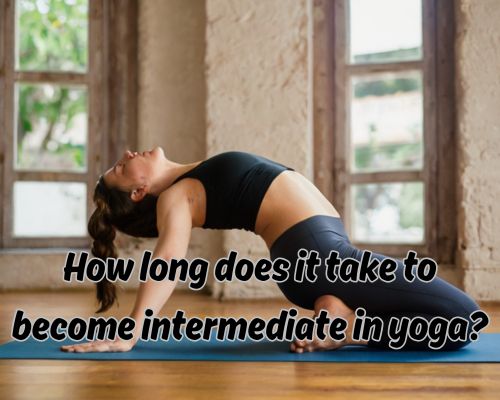How Long Does It Take to Become Intermediate in Yoga: A Practical Guide
Yoga is a transformative journey, a practice that evolves with dedication, patience, and discernment. The progression from beginner to intermediate yoga is unique for everyone.
It is influenced by individual circumstances like the style of yoga practiced, the frequency of practice, and one’s anatomical characteristics. On average, practitioners might find themselves moving towards an intermediate level within several months to a couple of years of consistent practice, but this timeframe can vary widely.

Becoming intermediate involves more than just mastering poses; it’s about fostering a deeper curiosity about one’s mind and body in relation to yoga.
Practitioners, see https://bikramyogamornington.com.au/, start appreciating the nuances of their practice, such as the connection between breath and movement and the engagement of core muscles to achieve stability and fluidity.
Such awareness gradually fortifies their yoga journey, making each session a step towards growth.
As they continue their practice, intermediate practitioners seek balance, experimenting with different styles and respecting their personal limits and capabilities.
This stage is not just a milestone but a continuing process of exploration that nurtures both skill and self-awareness. The path may be challenging, yet each pose and meditation offers rewarding insights, encouraging a lifelong engagement with yoga.
Developing a Consistent Yoga Practice
Establishing a regular yoga routine requires patience and discernment.
As one transitions from basic to intermediate levels, integrating core elements like balance and flexibility, alongside mastering breathing techniques such as ujjayi breathing, becomes vital.
Transitioning from Beginner Yoga
Transitioning effectively involves gradually incorporating intermediate poses into one’s routine.
Beginner yoga focuses on foundational asanas and building basic flexibility and strength.
With consistent practice, individuals can begin to experiment with advanced variations of familiar poses.
Discernment is crucial in ensuring that transitions are smooth and do not push the body beyond its limits. Incorporating mindfulness and body awareness ensures safe progression.
Core Elements of Intermediate Yoga
Intermediate yoga emphasises mastering core strength and flexibility, which are essential for stability and balance in more complex poses.
Asanas during this stage often require deeper concentration and core engagement.
Students are encouraged to maintain patience as they explore these poses, understanding that achieving them requires steady, patient effort.
Focusing on the quality and precision of each pose, rather than speed, promotes a deeper understanding of one’s capabilities.
Understanding and Mastering Pranayama
Pranayama, the art of breath control, is an integral part of developing a consistent yoga practice.
Mastering techniques like ujjayi breathing enhances concentration and supports the transition to intermediate yoga.
Effective breath control opportunities help in managing the challenges posed by difficult postures.
Pranayama aids meditation by fostering a calm and focused mind, thus improving overall practice quality. Cultivating this skill underscores the importance of integrating breath work into regular yoga sessions, see https://bikramyogamornington.com.au/.
Advancing to Intermediate Poses
Progressing to intermediate yoga involves developing greater body awareness, enhancing core engagement, and improving flexibility.
It requires consistent practice and the application of advanced techniques to transition from foundational poses to intermediate ones.
Key Intermediate Poses and Variations
Intermediate poses often challenge balance, strength, and flexibility.
Awkward Chair Pose and Reverse Warrior Pose are excellent for building leg and core strength while improving balance.
Poses such as King Dancer Pose and Half Moon Pose demand focus and flexibility, particularly in the hip and hamstring areas.
Mermaid Pose and Bird of Paradise offer a sophisticated challenge for intermediate practitioners, requiring deep shoulder opening and concentration.
Incorporating variations like Revolved Triangle Pose can help in enhancing body awareness and stability.
Building Strength and Mobility
Developing strength and mobility is crucial for advancing in yoga.
Core strength is essential, and poses like the Boat Pose focus intensively on this area.
Dolphin Pose, an intermediate variation of Downward Dog, aids in shoulder opening and core engagement.
The Four-Limbed Staff Pose or Chaturanga Dandasana builds arm and back strength, which is foundational for more advanced postures.
Warrior III and Eagle Pose help improve stability and balance.
Headstand (Sirsasana) and Shoulderstand can be incorporated to build upper body strength and enhance balance, crucial for more advanced inversions.
Incorporating Advanced Yoga Techniques
Understanding and employing advanced techniques is key to refining one’s practice.
Vinyasa flows with controlled transitions can aid in building stamina and coordination.
Techniques like controlled breathing and alignment adjustments enhance the practice. A yoga teacher often guides these adjustments.
Utilising props can aid in mastering challenging poses such as Camel Pose or Lotus Pose.
Transitioning from basic poses to ones like Pigeon Pose or Crow Pose introduces more intricate elements of balance and strength.
Practising Chair Pose variations helps exploit core stability and leg strength development. These are essential for advanced progressions like Wheel Pose or Standing Postures.